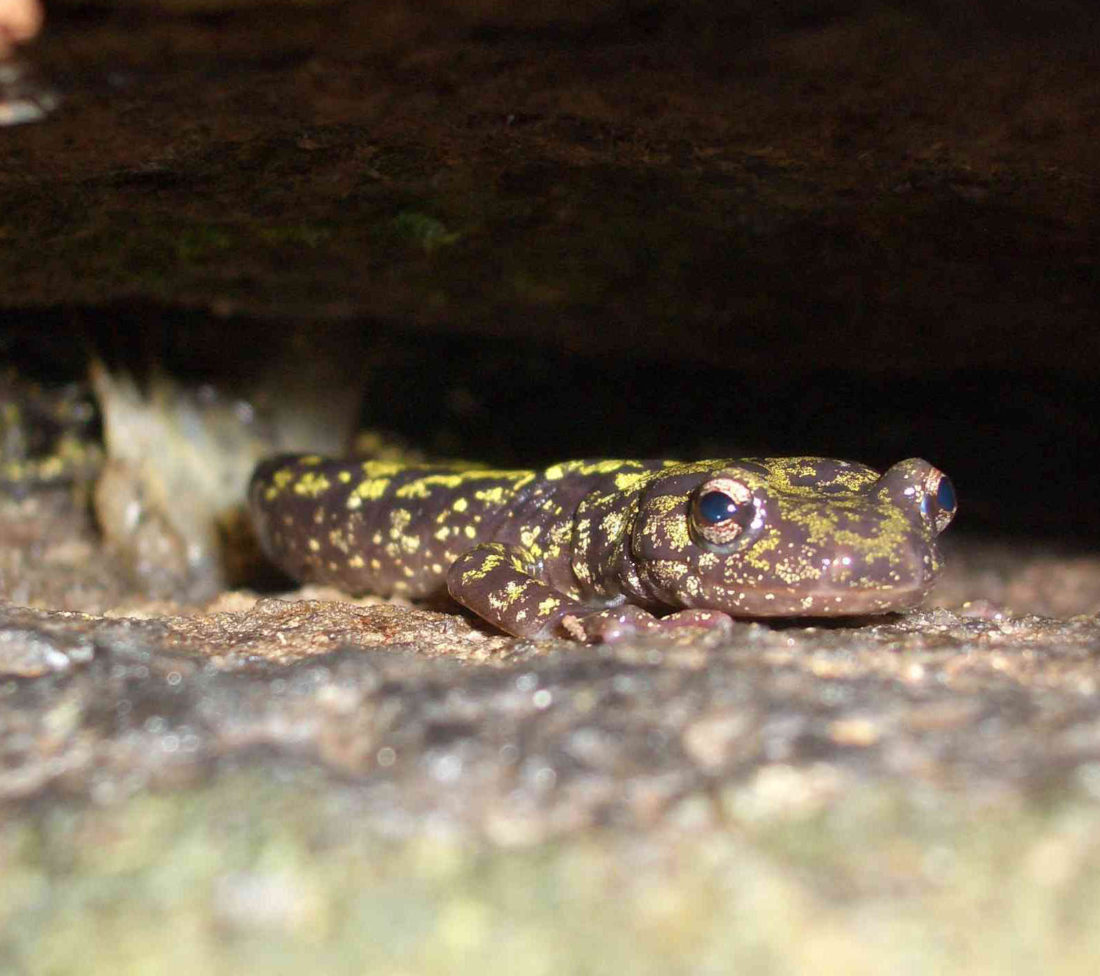BY JOSH KELLY
In the headwaters of the Chattooga River, on the summit and high slopes of Brushy Mountain in the Nantahala National Forest, lie 37 acres of considerable interest, spread across two tracts. One of them consists of exceptional old-growth forest, with trees that are hundreds of years old. The second tract is not old growth; the trees there are about 90 years old, but both parcels provide habitat for native species, including the critically imperiled green salamander. It’s a beautiful sight to behold — but it may soon be gone, since the U.S. Forest Service has earmarked the area for logging.
The federal agency knows full well that Stand 35-41 consists of exceptional old-growth forest habitat. In 2018, when the Nantahala National Forest first proposed cutting these two tracts as part of its Southside Project, the Chattooga Conservancy identified Stand 35-41 as old growth, and the Forest Service acknowledged that it meets its standards. Independent surveys have also documented, and the Forest Service has acknowledged, the existence of a healthy green salamander population in and around the area in question. These facts are not in dispute.
Nonetheless, the agency has decided to move forward with logging these two stands. They claim to want to create wildlife habitat even though these mature forests are already habitat for many important species.

With that in mind, on Aug. 11, MountainTrue made an unconventional offer: to pay the Forest Service to leave Brushy Mountain alone. Leave the ancient trees on the summit standing. Let the green salamanders forage through the forest between their breeding rocks without having to contend with logging roads and deadly sun exposure. We were willing to match any price bid on the value of the cut timber in exchange for what would amount to a 100-year carbon lease on those acres.
Ours was the best, most generous offer, yet the Forest Service rejected it without response or any evidence of serious consideration. Instead, the agency prefers to sell these old-growth and mature trees at a discount and destroy a rare and sensitive ecosystem. It should be noted that the offer wasn’t submitted through the timber bidding process, since any resulting contract would have required MountainTrue to do the very thing we were seeking to avoid: logging Brushy Mountain. Nonetheless, simply ignoring our proposal makes no sense.
A crucial tool
There would have been precedent for this kind of transaction. Markets such as the National Carbon Exchange enable emitters to offset their carbon pollution by increasing carbon storage elsewhere. Old-growth forests, whose trees have been standing for centuries, hold tremendous amounts of carbon. Cutting these trees releases that carbon — tons of it — into the atmosphere, where it will worsen the impacts of climate change. Cutting forests, particularly old-growth forests, produces massive amounts of greenhouse gas pollution. Keeping these remarkable tracts of forest standing is a crucial tool for fighting the climate crisis, and that’s something we’re willing to pay for.
Furthermore, our offer would have saved taxpayer dollars and made the most business sense for the cash-strapped Forest Service. The agency would have gotten more money by leaving these old-growth and mature trees standing and wouldn’t have incurred the expenses associated with administering the sale and overseeing road-building and logging activities.
The Forest Service’s decision to go ahead with logging these two stands flies in the face of our climate reality, as well as recent action taken by the president. Earlier this year, the Biden administration issued an executive order titled “Strengthening Forests, Communities and Local Economies,” which directs the Forest Service to inventory all old-growth and mature forests, in part to better protect these public forests’ carbon storage function.
Meanwhile, on June 23, Tom Vilsack, who heads the U.S. Department of Agriculture (the Forest Service’s parent agency), released a memorandum on “Climate Resilience and Carbon Stewardship of America’s National Forests and Grasslands” which, among other things, makes this claim: “All national forests currently protect or limit management actions in old-growth stands through forest-specific, land-management-plan components or by specific Secretarial direction.”
If that were true, Nantahala National Forest administrators would have abandoned the Southside Project long ago. Instead, the new forest plan for the Nantahala and Pisgah national forests leaves it up to the district rangers to decide whether to cut old-growth forests. With no management plan or direction from the secretary of agriculture protecting old growth in Southern Appalachian national forests, Nantahala has been allowed to reject a higher bid, ignore its own findings and sell the logging rights for a documented old-growth stand.
Do the right thing
Logging these critical tracts will threaten an at-risk species, worsen climate change impacts and permanently damage an exceptional stand of old-growth forest. But it’s not too late. Forest Service leaders could still decide to cancel the contract — as the agency has done in other instances in recent years — and scrap this misguided project altogether, preserving these forests for future generations. Short of that, the agency should reconsider and accept the best, most fiscally, environmentally and socially responsible bid for these trees — the offer made by MountainTrue.
WNC native Josh Kelly, a graduate of the UNC Asheville biology program, serves as public lands field biologist for MountainTrue.






The Forest Service…. a complete travesty. I love though how they present their dissembling rationale for their only real mission… getting the cut out.
…and many thanks to MountainTrue in regard to your sustained efforts with all of this.
The article implies that the final final decision has not been made… Who and how do we influence the decision makers?
Any help would be appreciated…
I attended a recent River Quality Summit at New Belgium. One of the top comments that came up in the survey had to do with educating the public and public awareness in general–as if the public being unaware is the reason the river is polluted and forests are being slashed. The truth is that the public is more aware and educated than most of our public servants. The public keeps speaking out about protecting forests. It’s the Forest Service, Asheville City Council, Buncombe County Commissioners and others who are to blame for so much of what’s wrong around here. They ignore the public left and right. Comprehensive Plans and surveys and summits are never going to get us there without strong leaders with backbone.
The Forest Service with its professional experts is tasked to provide the best solution for all – it is not tasked to only leave the environment alone. All land can benefit from management to have successional growth- to support various species – to provide for our needs too. I trust these specialist / professionals – to want and work toward the best solution considering a huge amount of variables protectionism is only one part – they consider many variables and the environment is very high on their decision making list